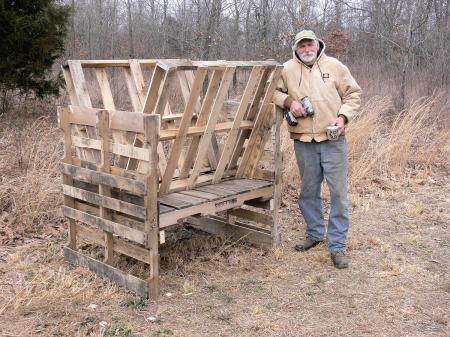
DIY writer for The New Pioneer magazine, Dave Boyt, came up with a simple hay feeder design built with pallets that prevents hay from being wasted by his two horses.
ďPart of the challenge of the design was to build a sturdy feeder by cutting the pallets as little as possible,Ē Boyt says. He used five standard size pallets for his feeder, plus additional 1 by 6ís and 2 by 4ís taken from other pallets.
The pallets donít have to be perfect, but Boyt emphasizes the importance of removing any nails that protrude or are loose.
Pallets will eventually fall apart and need to be replaced, he adds, so itís important to regularly check the area for nails and decayed wood and to build a new feeder when necessary. When possible, use pallets made of oak wood, which will last longer than soft pine or other wood pallets.
To start, Boyt determined the height he wanted for the feeder so that his horses could reach over the top. He created a base 24 in. tall for Trooper and Cody (15-hands tall quarter horses), by screwing 2 by 4ís on the sidewall pallets to support a horizontal pallet, securing everything with 4-in. deck screws.
Four 1 by 6ís are screwed into the sidewalls at an angle, with about 6 in. between them at the base to support the pallets. Once the pallets are in place, four more 1 by 6ís are added inside to secure them. Boyt made sure to use screws that didnít protrude.
He also used a cordless reciprocating saw to cut off excess ends of the boards and to remove a few boards in the angled pallets so that hay could be pulled from the sides, though the horses prefer to eat from the top.
The feeder is solid enough to be free- standing and worked well over its first winter, Boyt says.
ďI donít throw a whole bale in. I pull the hay apart so they can get at it more easily,Ē he notes.
With different size pallets, feeders could be adapted for other livestock like sheep or cattle, Boyt adds. Pallet feeders are cheap and easy to build so they are a good option even if they have to be replaced after 3 or 4 years.
Heís already figured out an improvement for his next feeder. ďAt the bottom of the feeder, I would add a place for grain or a salt block,Ē he says.
Contact: Dave Boyt, 20632 Parrot Rd., Neosho, Mo. 64850 (ph 417 455-2698; dboyt.42@gmail.com).
